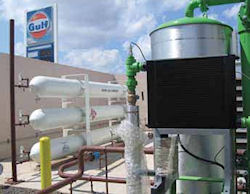Green Airport Plaza Sprouts Up at Newark Liberty
 |
|
Facts & Figures Project: Onsite Airport Plaza Owner: The Port Authority of New York and New Jersey Location: Newark (NJ) Liberty International Airport Plaza Design, Development & Operation: Airport Plazas, LLC, a subsidiary of GAZ Reality, Inc. Services: Gas station/convenience store, car wash, light auto repair & towing Cost: $5.9 million Convenience Store: 7-Eleven Fuel: Clean Energy General Contractor: Aventura Construction Corp. Engineering Firm: Eryou Engineering, Inc. Architect: Diesel Architecture PLLC Retail Sales/Fuel Forecasts: IMST Corp. Potential Traffic: More than 35 million annual passengers & 25,000 airport workers |
The plaza's 1.4-acre site may be small, but it bustles with traffic from two main roads that lead to Terminal A. Newark Liberty currently serves about 36 million passengers per year; growth projections predict traffic will swell to more than 50 million, reports airport media relations representative Ron Marsico. To plan for the growth, the airport is evaluating what services are in demand by the traveling public and how the airport can best satisfy their needs.
Passengers, however, aren't the plaza's only target customers. The 25,000 people who work at the airport are also prime prospects. Even more employees will be needed as passenger traffic grows and Terminal B infrastructure improvements are complete, Marsico notes. Plans by Continental Airlines and FedEx to expand their hubs at the airport are also expected to boost the plaza's customer base.
When the Port Authority of New York and New Jersey saw the need for an onsite fueling station and additional food service outside the terminal, it issued a request for proposal. The RFP sought a firm to design, construct and operate a gas station located where traffic enters the main central terminal area.
Airport Plazas, LLC, a subsidiary of GAZ Reality, Inc., hired IMST Corp. to help prepare its bid by studying the site's traffic. IMST projected that the plaza's primary customer segment would be airport employees. The next most prominent group would be taxi and limousine drivers, followed by the traveling public. As bid winner, Airport Plazas designed a plaza that would cater to what seemed to be an underserved market.
According to its contract with Airport Plazas, the Port Authority will earn $7.7 million over a 20-year lease, plus the residual value of the infrastructure created by Airport Plazas.
The Arrival of the Slurpee
While other U.S. airports may have gas stations and convenience stores, Newark Liberty is the first to add an on-property 7-Eleven. With more than 7,600 stores in the U.S. and Canada, and close to 20,300 locations overseas, 7-Eleven is world's largest operator, franchisor and licensor of convenience stores.
 |
Nearly one-third of the 6 million people who stop at a U.S. 7-Eleven store each day purchase immediately consumable food, Keurian reports. Plaza officials expect the company's trademark Slurpee ice beverages, Big Gulp fountain soft drinks and Big Bite grill items to appeal to people driving into the airport. Of all its proprietary products, 7-Eleven sells more fresh-brewed coffee than anything else, notes Keurian.
George Abi Zeid, president and CEO of Airport Plazas, says the 3,500-square-foot 7-Eleven store will help extend the airport's concession options beyond passengers to the larger airport community.
"Post 9/11, access to the terminals and the location of concessions have changed," says Abi Zeid.
Beyond Unleaded


Airport Plazas partnered with Clean Energy to build and operate a gas station capable of offering compressed natural gas (CNG). Clean Energy vice president Daniel Huberty says CNG provides a cleaner, less expensive fuel option for taxis and shuttle fleets serving the airport and densely populated New York metropolitan area. Clean Energy is the nation's largest provider of natural gas fuel for transportation.
Installing a facility in Newark was strategic for Clean Energy, because the location is critical to vehicles driving in and around New York City. "It's convenient for end-users, and it's effective marketing for CNG," says Huberty.
Besides Newark Liberty, Clean Energy has a presence at 23 other U.S. airports. In late July, it was in development with nine others. At some airports, the company builds and operates CNG fueling stations; at others, it installs CNG fueling services at existing multi-fuel airport stations. The Newark plaza, notes Huberty, represents a much larger market for the company.
The convenience of a gas station next to the car rental return affords customers the opportunity to refill rental cars before returning them. At Newark Liberty, car rental customers can be charged as much as $8 per gallon. Based on current market prices, customers could save more than 50% buying gas at the airport plaza.
Plaza Perks

The plaza's dual-bay car wash is expected to attract airport employees and transportation service providers. A shop for light auto repair allows them to drop cars at the plaza for service and retrieve them during lunch or on the way home.
Drawing inspiration from airline frequent flier programs, Airport Plazas offers a loyalty program that awards customers points toward future plaza purchases.
A Prototype
Abi Zeid feels his company is at the forefront of the "Airport as a City" business model.
"An airport is much more than a transportation hub," he says. "An airport like Newark Liberty offers a demographic of more than 30,000 people in a concentrated area. If you were developing in suburbia across most of America, you would be thrilled to have such a captive audience."
The Newark Airport Plaza is a prototype for other facilities in development by Airport Plazas. At 1.4 acres, it's smaller than the ideal size of 2 to 3 acres, Abi Zeid says, like the plaza being developed at John F. Kennedy International in New York.
More Than Storefronts
"This isn't just about offering service to an untapped market," Abi Zeid relates. "This is about helping the environment and putting people back to work."
The Newark plaza, he notes, will add nearly 50 new jobs to the local economy.
"The response to our ad was simply overwhelming," reports Aari Jubran, general manager for the plaza. "We needed a dedicated voicemail box for the job inquiries. On an average day, there were over 100 voicemail messages, not to mention the volume of email and faxed resumes. Seeing such a flood of inquiries was a sobering measure of the current economic climate."
|
Building the Plaza Before the Newark Airport Plaza was built, its spot along the shoulder of the main artery leading into the central terminal area had been vacant since Newark Liberty opened in 1928. Because the plaza was built as part of an existing airport, Diesel Architecture PLLC designed it to fit in with the other buildings on the grounds yet be inviting to motorists in its own right. Local building materials, low-consumption plumbing fixtures and LED lights help make the plaza "green," notes Diego Steisel, RA, president of Diesel. The building also meets requirements of the New Jersey Department of Energy. Special tunnels in the car wash conserve water by reclaiming and recycling it. The property itself was a challenging parcel to work with. It seemed to have more buried utilities than a New York City street intersection, comments Dennis Eryou, of Eryou Engineering. "There were tremendous challenges involving underground utilities," agrees Aventura Construction Corp. owner Frank DeMeyer. "It seemed as though every utility in the airport ran through the property, and we were advised on many occasions that any disruption is a matter of national security." At first, DeMeyer lost sleep over the situation, but cooperation between the local utility companies, contractors and Port Authority improved his outlook. Redesigns, however, were numerous. After a close call driving steel piles adjacent to high voltage cables underground, the project was completed safely and without incident, he reports. |
FREE Whitepaper
Fairbanks International Airport Baggage Transport Conveyor Enhanced With Mod Drive™ System
Airports face a host of unique industry challenges, such as meeting efficiency regulations and seeking out the best maintenance practices to reduce costs and keep operations flowing. In today’s current economic climate, any potential cost savings can go a long way.
In 2019, Alaska’s Fairbanks International Airport (FAI) sought to modernize its equipment and operations. They were dissatisfied with the performance of the gearmotors on their baggage transport conveyors and began searching for new suppliers. Regal approached FAI with a solution that could improve equipment performance and simplify maintenance, with the added benefit of energy cost savings: the Hub City® MOD Drive™ system.
This white paper discusses the hardware deployed, the test results and the annualized expectations for ROI.








